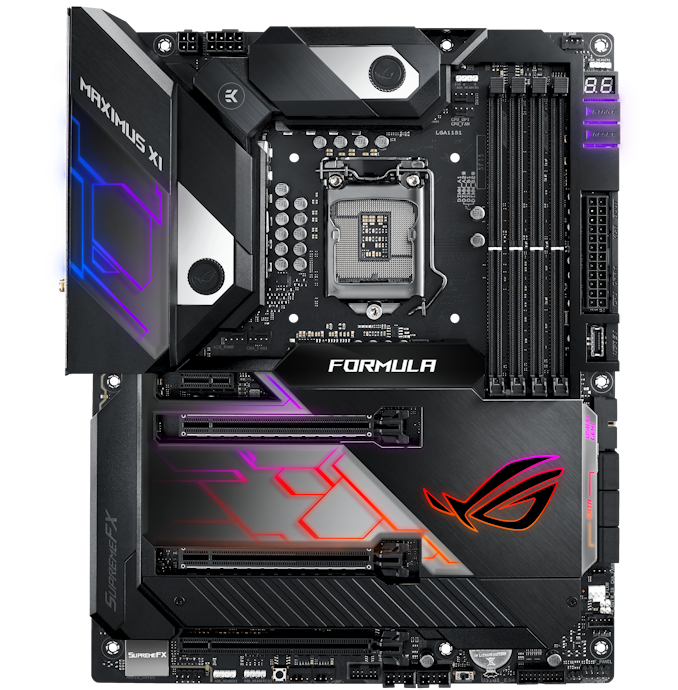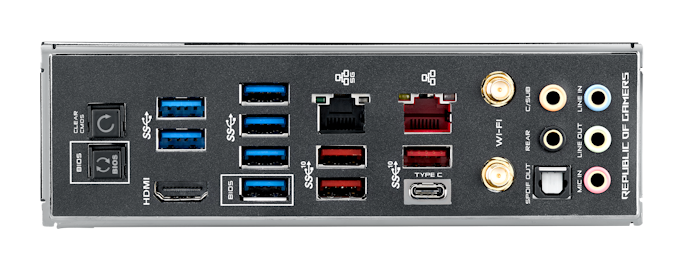Intel Z390 Motherboard Overview: 50+ Motherboards Analyzed
by Ian Cutress & Gavin Bonshor on October 8, 2018 10:53 AM EST- Posted in
- Motherboards
- Intel
- MSI
- Gigabyte
- ASRock
- EVGA
- Asus
- NZXT
- Supermicro
- Z390
ASUS ROG Maximus XI Formula
Another high-end board on the Z390 chipset from ASUS is the ROG Maximus XI Formula which has a similar rear panel cover as the Maximus XI Code along with what looks to be a near identical PCIe slot layout. Other similarities stretch to the use of a PCB cover which looks to have a little more flair and more RGB than the Code, but from a quick glance, the entirety of what's visible PCB wise looks to be identical to the ROG Maximus XI Code; this is not necessarily a bad thing. The biggest difference and impressive inclusion on the Formula over the Code is the EKWB power delivery water block which allows enthusiasts to hook it up to custom water cooling loops for even lower VRM temps; perfect for users to overclock their processors and NOT have to worry about the quality of the power delivery heatsinks.
The Maximus XI Formula keeps the same power and reset buttons with a LED debug in the top right corner. There are four RAM slots with support for DDR4-4400 with a maximum capacity of up to 64 GB in total. Built-in into the board is a pair of PCIe 3.0 x4 M.2 slots (one with SATA support and one without) which feature a pair of heatsinks which amalgamate into the boards overall aesthetic. Also present is a total of six SATA ports with support for RAID 0, 1, 5 and 10 arrays.
The board has three full-length PCIe 3.0 slots which allow for two-way SLI and three-way CrossFire multi-graphics card support at x16/x0/x4 and x8/x8/x4 respectively much like the majority of the Maximus XI boards including the Hero, Hero (Wi-Fi) and Code. This also stretches to the onboard audio and networking with a Supreme-FX S1220 8-channel HD audio codec and a single Intel I219V Gigabit NIC on the rear panel.
With a host of quality connections integrated, there's dual LAN with one port being powered by an Aquantia AC111C 5 G NIC and the second by an Intel I219V Gigabit controller. Wireless networking is provided by a Wave 2 2T2R 802.11ac Wi-Fi adapter and a single HDMI 1.4b video output. The same pair of buttons consisting of a BIOS Flashback and clear CMOS is featured much like the Code, and the onboard audio is controlled by a gaming-focused SupremeFX S1220A HD audio codec. Last but not least is USB support, with three USB 3.1 Gen2 Type-A ports, a single USB 3.1 Gen2 Type-A port and a hefty six USB 3.0 Type-A ports completing a packed rear IO.
The ASUS ROG Maximus XI Formula has an unknown price as of yet, but is one of the top ASUS Z390 boards at launch with a clear focus on gaming based features and enthusiast grade components such as the EKWB made power delivery heatsink. The Formula is primarily targeted at gamers and enthusiasts with overclocking as a focus and the inclusion of 5 Gigabit LAN sets this board apart from the most of the Maximus XI range.












79 Comments
View All Comments
Valantar - Wednesday, October 10, 2018 - link
That would be pretty shocking, yeah, but the sheer size of that lump of metal still has me a bit worried. Guess that's what you get when you try to squeeze power delivery for a CPU that (likely) pulls >300W when overclocked into an ITX board (and refuse to use riser boards like before, for some reason).FXi - Monday, October 8, 2018 - link
The power feed also changed with z390 I believe at least in the Asus models it did. The power feed of the 370 was "enough" to drive the newer 9700/9900 but there is a difference there that may impact enthusiasts. I don't think it enough to warrant an upgrade but something to consider.Also people should remember that while it is still a bit of a ways off, wifi is going to change to Wifi6 or 802.11ax starting now and probably seeing much of the changeover during 2019/2020 depending on adoption choices. And there is also pci-e 4.0 to consider next year probably that should be thought about before people do "marginal" upgrades from 370 era chipsets.
FXi - Monday, October 8, 2018 - link
Silly thing posted in edit window. Sorry power delivery and other points covered by you. Would have edited if I could have found that optionDanNeely - Monday, October 8, 2018 - link
Other things to look forward to in the next few generations are: Less-hacky USB3.1 implementations (eg this articles speculation that a 10g port will need to eat 2 HSIO lanes instead of 1, and still needing an extra chip to support USB-C). Spectre/Meltdown fixes in hardware. A reduced DMI bottleneck between the CPU and chipset (either just from upgrading the link to PCIe4/5, moving some of the peripheral IO onto the CPU, or both.Valantar - Wednesday, October 10, 2018 - link
Considering that the maximum theoretical bandwidth of PCIe 3.0 x1 is 984.6MB/s, you _need_ two PCIe lanes (and thus two HSIO lanes) for a USB 3.1G2 (1.25GB/s) controller unless you want to significantly bottleneck it. That's not "hacky", that's reality, even if this leaves a lot of bandwidth "on the table" if this only powers a single port (which it rarely does, though, and given that a full load on two ports at one time is unlikely, running two 1.25GB/s ports off two .99GB/s lanes is a good solution).Moving DMI to PCIe 4.0 will be good, though, particularly for multiple NVMe SSDs and >GbE networking.
DanNeely - Wednesday, October 10, 2018 - link
Splitting the traffic over 2 HSIO lanes is a hack because it'd require something to split/combine the traffic between the chipset and usbport. That in turn has me wondering if the speculation about the implementation being done that way is correct, or if the Z390 has 6 HSIO lanes that can run 10Gbps instead of the 8 that the rest top out at for PCIe3repoman27 - Thursday, October 18, 2018 - link
The implementation is absolutely not done that way. HSIO lanes are simply differential signaling pairs connected to a PCIe switch or various controllers via a mux. The PCH has a 6-port USB 3.1 Gen 2 xHCI, which can only feed 6 HSIO muxes. The back end of that xHCI is connected to an on-die PCIe switch which in turn is connected to the DMI interface. That DMI 3.0 x4 interface is already massively oversubscribed, but it is at least equivalent to a PCIe 3.0 x4 link, which is the most bandwidth that can be allotted to a single PCH connected device.Srikzquest - Monday, October 8, 2018 - link
HDMI 2.0 is available in Asus and Gigabyte's ITX boards as well.gavbon - Tuesday, October 9, 2018 - link
Thank you Srikzquest; updated the tables, obviously missed this yesterday :) - Thanks againHickorySwitch - Monday, October 8, 2018 - link
Correction:https://www.asus.com/us/Commercial-Servers-Worksta...
It says under "Specifications" that the board sports HDMI 2.0[b?]